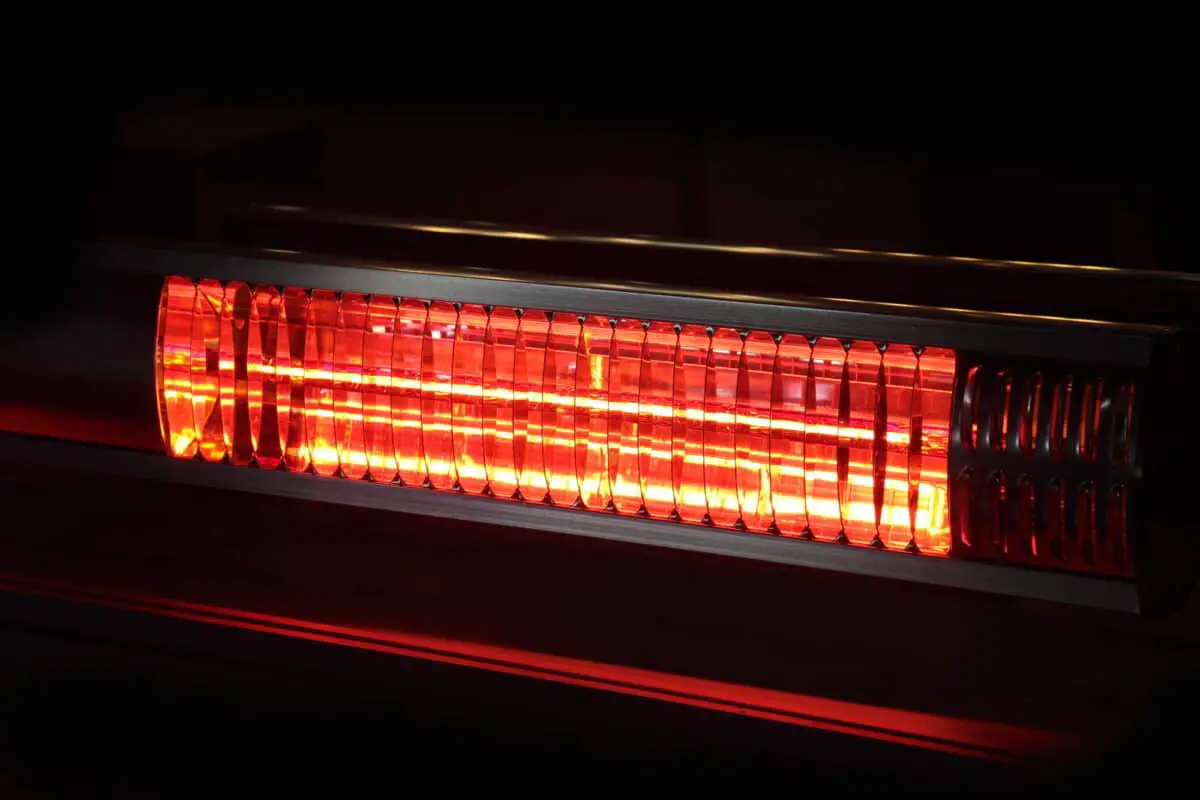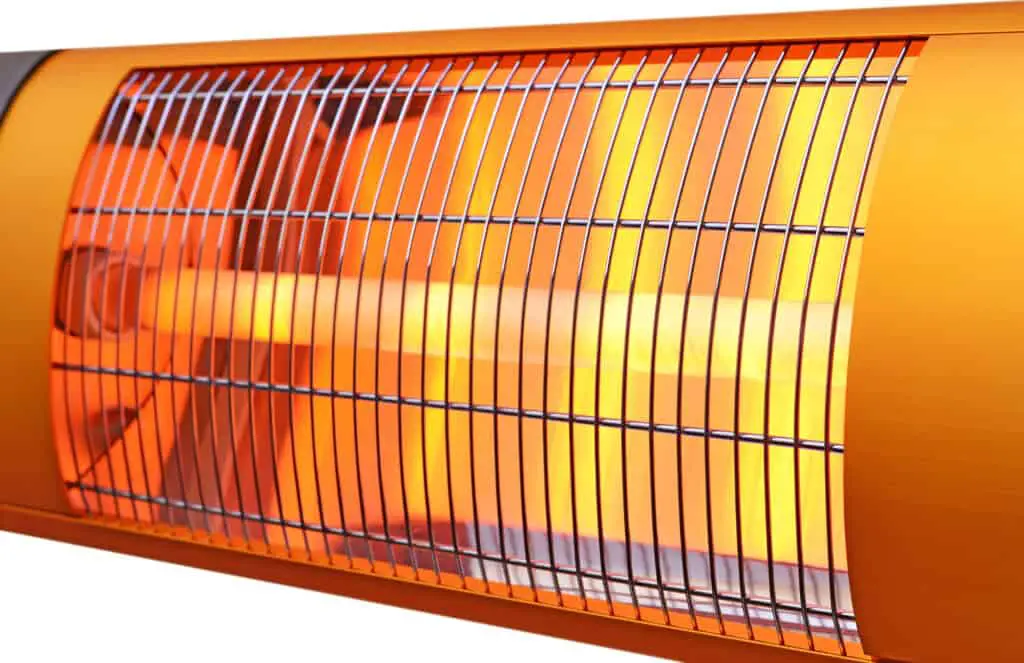How much is the patio heater’s electricity usage?
The average patio heater electricity usage requires 2,000 watts or 2 kilowatts (kW) of power. This costs, on average, $0.49 per hour on full power.
As the colder nights start to draw in, you might find yourself getting a little harder while spending time on your patio.
An excellent solution for this is an electric patio heater, but when purchasing a patio heater, there are quite a few factors to consider.
Read on to find out more fascinating facts about electric heaters and what other options are available when deciding on the best way to heat up your patio.

Table of Contents
Patio Heater Electricity Usage and Running a Heater for 24 Hours
Electric patio heaters are one of the most economical and safest ways of heating an outside area; they are also very portable and require very little setup.
For example, let’s use a 2,000-watt patio heater.
To get the hourly rate, check your electricity provider’s invoice. In this example, the cost per kWh hour is $0.49.
If you need to find the kW from Watts, divide the Watts by 1,000.
2,000 Watt/1,000 = 2 kW
2 kW x $0.49 = $0.98 Cost Per Hour
To run a 2,000-watt (2 kW) heater for 24 hours, you would take the product of cost per hour x 24 hours.
$0.98 x 24 = $23.52.
Although using your electric heater for 24 hours might be tempting, it would be inadvisable.
Continued uninterrupted use of your heater would destroy the heating elements quite quickly.
There are electric heater models designed to be used indoors or left on overnight, but it would still be advisable to avoid 24-hour continuous use.
Related Article: Infrared Heaters Energy Use
You can check out an assortment of ELECTRIC PATIO HEATERS here!
Will a 2 kW Heater Heat My Patio?
When heating a patio, there are several things to take into account.
Some factors to consider would be the outside temperature, wind in the area, time of day, and the space you are heating.
The 2 kW patio heater is generally adequate for heating a patio area on a chilly evening.
However, if you plan on using a heater in more adverse conditions, you might want to consider another type of patio heater.
Heating patios in the winter will require more energy, which usually means more patio heaters. This will undoubtedly increase the patio heater’s electricity usage.
Types of Patio Heaters
When deciding on purchasing a patio heater, you will be happy to know there is one for every need.
There is often debate between electric and gas patio heaters. Ultimately, it comes down to which types are best for your environment and wallet.
If you have a patio with access to a power outlet, we suggest trying an electric patio heater. This is the easiest fix to your heating problem.
Before purchasing, you should assess the patio and its outside conditions.
- How much space needs to be heated?
- Will one patio heater suffice?
- How many watts would you need to heat the area?
Remember, this will increase your patio heater electricity usage, so find the most efficient heater for the money.
There are other options if you don’t have access to electric power.
Gas Patio Heater
A gas patio heater uses gas cylinders or cartridges that can be purchased or exchanged at most gas stations, hardware stores, and supermarkets.
The gas used is either butane or propane.
These fuel sources burn at incredibly high heat. The flame can often be seen when using this type of heater, producing a warm atmosphere.
Gas patio heaters produce carbon monoxide and should never be used indoors or in areas with poor ventilation.
Related Article: The Truth About Electric Heaters and Carbon Monoxide Poisoning: Best Insight
GAS PATIO HEATERS can be found here!
Wood-Burning Fire Pit
Another option to use when there is no electrical power source is a wood-burning fire pit.
This is not the most efficient way of heating an area, but the fuel cost can be reduced to a minimum depending on your access to wood.
To save money, you can use deadwood from your local forest or wooded area if permitted to take it.
If you don’t have a wooded area near your home, you must buy pre-cut wood from the store or a local neighbor.
Some people post signs on their lawns selling a bundle of wood at a reasonable price.
I usually see a small bundle for about $5.00 along the roads.
Fortunately, my wife and I do quite a bit of tree cutting and trimming, offering a season’s worth of firewood.
However, you do have to consider the added cost of buying wood and how many logs you will need to burn with typical use.
One benefit is not worrying about patio heater electricity usage.
Most cities and towns prohibit burning household rubbish, plastics, or other materials not made for burning.
Most fire pits are made of metal that can become extremely hot on the outer casing.
Children should never be left unsupervised around an active fire pit.
Flames will come from the fire pit, so it should never be left unattended.
The flames should be extinguished before going inside for the night using water and/or dirt. If not extinguished property, the flame can return with the remaining hot embers.
You can find WOOD-BURNING FIRE PITS here if you are interested!
Which Electric Heater Has The Lower Patio Heater Electricity Usage?
When it comes to electric heaters or space heaters, there are five choices.
- Oil Filled: This type of heater uses a radiator-style casing filled with oil. Once plugged in, the elements warm the oil and eventually radiate heat. An oil-filled heater costs approximately $0.13/hr.
- Fan Heater: Developed to push heat out from a warm element, the fan circulates the air around the area that requires heating. A fan heater costs approximately $0.17/hr.
- Convector: A convector heater takes in cold air, heats it, and ultimately heats the air in a room. Unfortunately, a convector heater would not be a good idea to try and heat an outside area. This type of heater costs approximately $0.17/hr.
- Halogen: This is the typical type of heater you will see on a patio or an outdoor area. They produce heat through their halogen lamps and heat the air using short airwaves. A Halogen heater costs approximately $0.10/hr.
- Radiant Bar: This is quite old technology. The radiant bar heater uses a wire coil that heats up when electricity is passed through it. The bigger the bar, the higher the temperature. The bar will glow and produce intense heat. This type of heater costs approximately $0.17/hr.
Which is Better, a Gas or Electric Patio Heater?
Both gas and electric heaters have benefits and challenges when it comes to what is best for you.
Both have their safety precautions to take.
A gas heater has the ability to be highly portable as it doesn’t need to be plugged into a principal energy supply.
They also provide a comforting glow that illuminates an area and gives a lovely aesthetic.
But gas heaters can be pretty cumbersome.
They require regular maintenance and produce carbon monoxide and other environmental pollutants.
Gas heaters also emit an odor and, when used excessively, require regular gas refills that can become quite expensive.
An electric heater is an excellent option as it costs very little to run and doesn’t pose any significant safety issues.
Electric heaters can be very lightweight and don’t require much setting up…literally a flick of a switch.
Electric heaters should never be used in wet conditions, never left outside, and always stored somewhere dry.
Once an electric heater needs extensive repairs, it is time to replace it with a newer model.
Related Reading: Electric or Gas Patio Heaters: Which One is Better? A Comprehensive Comparison

Conclusion
In past years, an electric heater was regarded as an expensive piece of equipment and was often frowned upon.
But with time and better technology, electric heaters are a lot more efficient.
Electric heaters are a preferred means of heating and are considered a safer, greener option.
You must check patio heater electricity usage using the formulas in the article.
Once you are comfortable with the decision, find an efficient heater, set it up on your patio, and enjoy cooler seasons.
As always, enjoy living the outdoor life!
